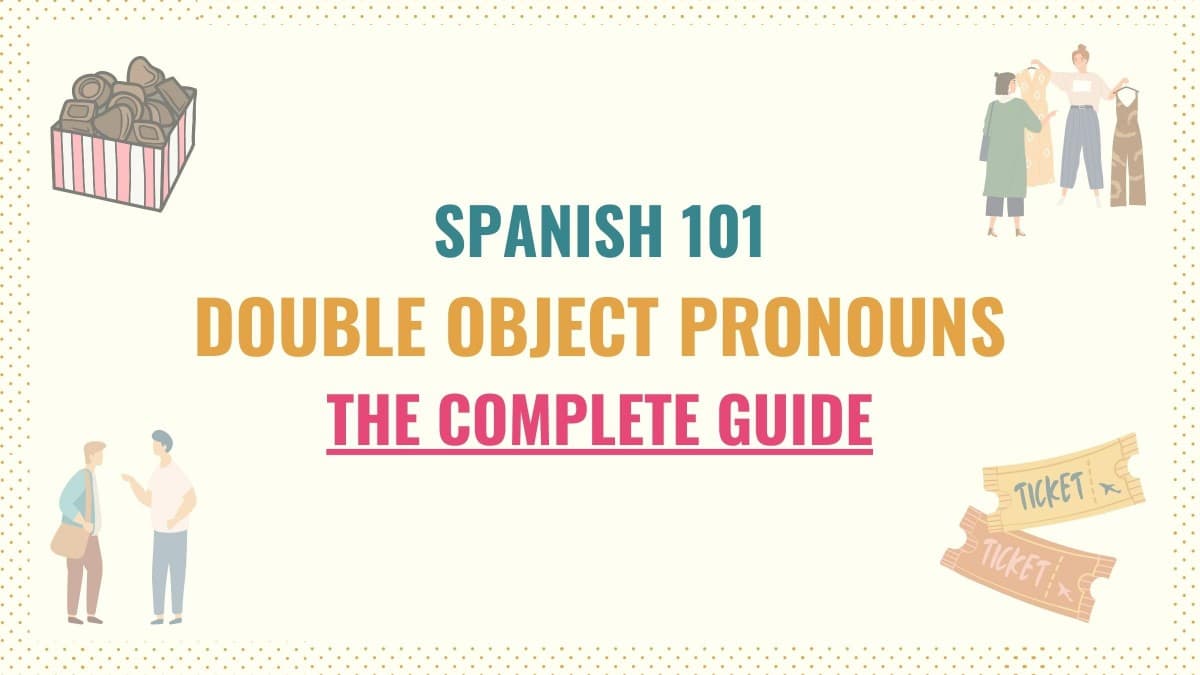Double object pronouns in Spanish are key to using direct and indirect object pronouns to the fullest. In other words, the foundations of double object pronouns allow you to combine direct and indirect pronouns in a sentence properly.
So, to help you master this topic, this is what we’ll cover in this guide to Spanish double object pronouns:
- What Are Spanish Double Object Pronouns
- How & When to Use Double Object Pronouns
- Order of Direct & Indirect Object Pronouns
- Key Points
- Downloadable PDF
- Practice Quiz
I’ve included charts and examples of double object pronouns in Spanish to make things easier.
Let’s start, shall we?
What Are Double Object Pronouns in Spanish
In Spanish, double object pronouns appear when a sentence contains both indirect and direct object pronouns. For example:
¿Esas son mis llaves? ¡Dámelas!
Are those my keys? Give them to me!
¡Qué bonitas flores! ¿Quién te las dio?
Such beautiful flowers! Who gave them to you?

Sentences with double object pronouns in Spanish are very common. And as you can see in the examples above, these sentences combine direct and indirect object pronouns.
Here is a chart with double object pronouns in Spanish:

Now that you know some of the most common combinations of Spanish double object pronouns, we’re about to learn how and when we must use them.
Take Note: We could use many types of Spanish pronouns in a sentence. However, double object pronouns only occur when using direct and indirect object pronouns at the same time.
When & How to Use Double Object Pronouns in Spanish
In Spanish, we use double object pronouns to simplify sentences containing indirect and direct objects. This not only shortens the sentence but also avoids unnecessary repetition.
Check the following pairs of examples. The first sentence contains both objects. The second, it’s an example of double object pronouns in Spanish, where the objects have been replaced. In both cases, I’ve underlined the direct object and bolded the indirect one.
Example #1
| Sentence with double objects | Sentence with double object pronouns |
|---|---|
| Mi mamá nos regaló estas flores. My mom gave us these flowers. | Mi mamá nos las regaló. My mom gave them to us. |
Example #2
| Sentence with double objects | Sentence with double object pronouns |
|---|---|
| Nora te mandó el correo ayer. Nora sent the email to you | Nora te lo mandó ayer. Nora sent it to you yesterday. |
Example #3
| Sentence with double objects | Sentence with double object pronouns |
|---|---|
| Tania le dio estos chocolates a John. Tania gave these chocolates to John. | Tania se los dio a John. Tania gave them to John. |
As you can see in the examples above, once the context is clear, Spanish double object pronouns keep the sentence simple and coherent.
Take Note: Check example #3. In Spanish, sentences which use both the indirect object pronoun for the third person and the indirect object are very common. It’s called duplication, and we do it to provide extra context since le and les could refer to any man, woman, female or masculine thing.
Order of Spanish Double Object Pronouns
When working as double object pronouns in Spanish, indirect object pronouns are always placed before the direct object pronoun. Here is the formula to double object pronouns:
[Indirect object pronoun] + [direct object pronoun]
Spanish double object pronouns can be attached to or placed before the verb depending on the verb form you’re using.
Double object pronouns are placed before the verb in:
- Negative commands
- Perfect tenses (such as the present perfect)
- Sentences with a conjugated verb
[Double object pronoun] + [conjugated verb]
No se lo des.
Don’t give it to him.
¿Por qué no me las has dado?
Why haven’t you given them to me?
Take Note: Notice that when using both third-person direct and indirect object pronouns, the pronoun se replaces le and les. We do this to avoid communication misunderstandings.
Double object pronouns are attached to the verb in:
- Affirmative commands
- Verbs in infinitive form
- Verbs in present participle form
[Verb] + [double object pronoun]
¡Dámelas!
Give them to me!
¿Por qué no quieres comprárnoslo?
Why don’t you want to buy it for us?
Sentences that use infinitive verbs or present participles are likely working with a conjugated verb. In that case, you also have the option to place the pronouns before the conjugated verb:
¿Por qué no nos las quieres comprar?
Why don’t you want to buy it for us?
Take Note: When attaching a pronoun to the verb, we’re changing the stress of the word. Because of this, we must add an accent mark in the vowel that comes immediately before the object pronoun. Dámelas. Prestánoslo.

Key Points
Spanish double object pronouns are essential since they’re used in most of our daily sentences. Here are some key points you should know:
- Double object pronouns in Spanish are sentences that use both indirect and direct object pronouns.
- We use them to simplify sentences and avoid unnecessary repetition.
- In a sentence with double object pronouns, Spanish indirect object pronouns always come before the direct object.
- The order of double object pronouns depends on the type of verb you’re using.
- Spanish double object pronouns are attached to the verb in affirmative commands, present participles, or infinitive verbs.
- They must be placed before the conjugated verb in negative commands, perfect tenses, or sentences with a single verb.
Download the Double Object Pronouns Cheat Sheet PDF
Learning about all the different types of pronouns, including object pronouns can be tricky. That’s why I’ve created a downloadable PDF with the rules, charts, and examples you need to effectively learn Spanish Double Object Pronouns.
Practice Quiz: Double Object Pronouns

Now that you’ve learned more about these pronouns, you should take the time to complete this Spanish double object pronouns quiz.





